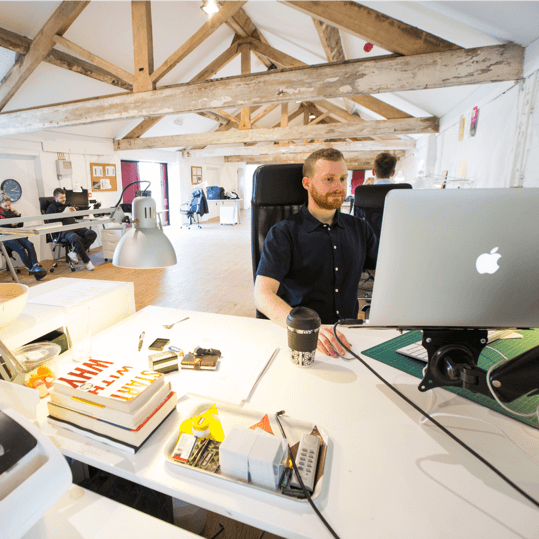Behavioral web designing in Dubai has focused on designing products, services, and experiences in consideration of human behavior and psychology. As a relatively new field, it amalgamates elements from psychology, design, and technology; it aims to craft more effective user-friendly products with greater engagement. The primary objective behind behavioral design remains to create intuitive user experiences that necessitate less effort for comprehension or operation an outcome that potentially stimulates heightened adoption rates among customers while enhancing their overall satisfaction.
The principle of nudging stands as a key in behavioral design: it embodies the concept of subtle persuasion, incentivizing individuals to make superior choices–all without curbing their freedom. A pertinent illustration lies with grocery stores; they strategically position healthy snacks at eye level an effort aimed towards nudging customers into opting for healthier alternatives. The store strategically enhances the visibility and accessibility of healthy options, encouraging customers to opt for healthier choices without imposing any force.
The idea of feedback loops represents another crucial principle in behavioral design: these mechanisms not only furnish users with information regarding their behavior but also incentivize them to sustain or alter their actions. Take for instance a fitness app; it offers users feedback on the strides they make towards achieving their fitness objectives – thus fostering continuous exercise and healthy decision-making. Designers in Dubai, through the provision of user behavior feedback, can craft products: that are not only more engaging – but also yield higher effectiveness.
Essentials of Behavioural Designing
Understanding human behavior and applying that insight to craft products, services, and experiences is at the heart of behavioral designing in Dubai. This discipline requires a deep grasp of the psychological and emotional factors that influence how people interact with the world around them.
Motivation is a key driver of behavior: people act based on their desire for pleasure, the need for social connection, or the ambition to achieve goals. By understanding these motivations, designers can create solutions that inspire action and engagement. Thoughtful web design plays a vital role here, presenting intuitive layouts, appealing visuals, and clear calls to action that encourage users to explore further.
Decision-making is another crucial component of behavior. Choices are shaped by emotions, beliefs, and past experiences. Incorporating this understanding into web development allows for creating seamless, fast, and user-focused experiences. When combined, strategic web design and effective web development empower businesses in Dubai to build digital products that resonate with users, encourage positive interactions, and ultimately achieve greater success.
Simplicity
Behavioural designing in Dubai holds simplicity which is a simpler design fosters understanding and enhances adherence to desired behaviors. To achieve this crucial simplicity a goal all designers should prioritize the focus must be on crafting clear, concise instructions; simultaneously minimizing task completion steps becomes equally significant.
Feedback
Behavioral design necessitates essential feedback: it equips individuals with progress information and allows them to adjust their behavior accordingly. Various methods of visual cues, sounds, or verbal feedback can provide this invaluable critique. When we design for feedback, we must consider several factors: the timing and frequency of the feedback; moreover, it’s crucial to ponder over the method of delivery.
Rewards
Behavioral designing wields rewards as a potent tool: they motivate individuals towards desired behavior; more than that, they fortify positive habits. Consequently, when we design for rewards two crucial factors demand our consideration: firstly, the type of reward; and secondly, its timing. Many forms of tangible items or social recognition, for instance, can provide rewards.
Behavioral Designing Techniques
Nudging
Nudging is a technique that involves influencing people’s behavior by making small changes in their environment. It is based on the idea that people are more likely to make certain choices if they are presented with them in a particular way. For example, nudging can involve placing healthy food options at eye level in a cafeteria or using social cues to encourage people to recycle.
Choice Architecture
Choice architecture is a strategic technique that involves the intentional design of choice presentation to influence human behavior. This concept stems from an overarching idea; that is, how choices are presented significantly impacts people’s decision-making processes. For instance, one aspect of this could be arranging options in a specific order; another could involve incorporating visual cues both methods subtly guiding individuals towards certain preferences or decisions.
Gamification
Using game-like elements to incentivize specific behaviors characterizes the technique of gamification; it operates under the premise that individuals tend to engage in enjoyable and rewarding activities. For instance to promote increased exercise or foster skill acquisition one may employ a system involving points, badges, and leaderboards: this is an example of gamification.
Applications of Behavioral Designing in Dubai
Product Designing
Utilizing behavioral design can exert influence on the user’s conduct during product usage. Understanding the user’s behavior and tailoring product design accordingly fosters increased user engagement or even specific desired behaviors. For instance, a fitness tracking app could incorporate reminders prompting users to complete their daily workouts; this strategy may bolster motivation for consistent adherence to personal fitness objectives.
Marketing
In marketing, we can harness behavioral design to actively influence customer behavior through a profound understanding of the customer’s behaviors and aligning our strategies accordingly–we motivate them towards making purchases or taking specific actions. Take for instance the use of the scarcity principle in retail; promoting limited-time sales or highlighting limited stock availability not only spurs urgency it also nudges customers into immediate buying decisions.
Policy Making
In policy-making, one can use behavioral design to actively influence citizen behavior: by comprehending how citizens behave and tailoring policies accordingly, we can motivate them to comply with or execute a specific action. A concrete instance is this – governments employing the default option principle not only guide but also encourage their citizens toward desired choices. For instance, a government may establish the default option of organ donation during driver’s license renewal; this strategy could potentially incentivize an increased number of individuals to become organ donors.
Future of Behavioural Designing in Dubai
In recent years, the relatively new field of Behavioural Designing has garnered significant attention. The future of this discipline appears promising as technology persists in its advancement. The escalating demand for user-centric products and services necessitates integrating behavioral design into the overall design process: it is fast becoming a critical component thereof.
The use of artificial intelligence emerges as a profoundly influential trend in future behavioral design AI enables designers to grasp user behavior more comprehensively a crucial aspect that facilitates the creation of designs that excel in intuition and user-friendliness. Through analyzing data from user interactions, AI identifies patterns and trends an invaluable tool for designers seeking to enhance the overall user experience; this method ensures informed decision-making about improvements.
The future of behavioral designing presents another trend: the pervasive use of gamification. Concretely, this concept involves imbuing non-game context apps or websites, for instance with game-like elements; these can include badges, rewards, and leaderboards. Through such strategic additions–the design fosters an experience that is not only more engaging but also significantly more motivating for its users.
Final Thoughts
The demand for sustainability is poised to exert a profound influence on the future of behavioral designing in Dubai: as consumers intensify their awareness of environmental impact, designers must pivot crafting products and services that not only epitomize eco-friendliness but also foster sustainable behavior. Achieving this delicate balance between usability/functionality and encouraging sustainability requires an intimate comprehension of user behavior; it necessitates proficiency in designing user-centric experiences – a challenging yet essential task.
The future of behavioral designing appears promising overall: as technology continues to advance and demand for user-centric design grows, we can expect behavioral designing to assume an increasingly crucial role in the overall process. Designers, by integrating AI, gamification, and sustainability into their designs; have the power not only to meet users’ needs but also to foster positive behavior change among them with their products or services.
FAQs
How can I integrate behavioral designing into my existing website?
Keep in mind several factors to integrate behavioral designing into your website: the user’s needs and emotions; the meaning of the activity–its experience is crucial. Furthermore, appropriate functionality that can provide an enhanced user experience should be considered as well. ‘Why,’ ‘What,’ and ‘How’ need to harmonize together – primarily dictated by the Why which establishes not just a purpose but also sets an emotional tone through identification with needs/emotions.
Why is feedback important in behavioral design?
Feedback is an important tool in behavioral designing because it helps designers understand how users are interacting with their products and services. By collecting feedback, designers can identify areas for improvement and make changes that better meet the needs of users.
How is behavioral designing in Dubai different from other types of designs?
Behavioral designing is a unique approach to design centrally focused on shaping human behavior through techniques grounded in psychology and behavioral economics. It necessitates an awareness of cultural context, and employing a multidisciplinary method is crucial for creating products and services that elicit positive user behaviors.





